NOTE: This post has large (400px) images side-by-side, so is best viewed full screen.
I took advantage of the holiday sales to purchase a small digital camera suitable for taking photomicrographs by pointing it into a microscope eyepiece. It is a technique I've used with film cameras in the past, starting fifty years ago when I used my father's Argus 35mm camera with my little "kit" microscope. My current (now "main") digital camera, a Nikon D40, has a lens much too large for this use. The eye relief of the eyepieces of my microscopes ranges from 9mm to 14mm. A camera's lens has to be short enough that the eyepiece's focus point can be put in or near the center of the iris diaphragm, or the image will suffer vignetting. A Canon SD1200, with its 6.2-18.6mm zoom lens, seems well suited to this use, and the price was right. I had already learned (reported here) that my son's SD1100 was useful for this purpose.
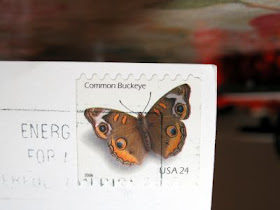
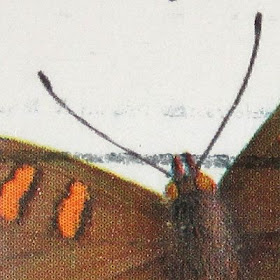
Most cameras these days have a Macro setting, and the Canon's is pretty good. These photos show the practical range available. The first is the whole image of a portion of a post card and stamp. Reproduced this size, its magnification is 2x on a 100dpi monitor, or 2.3x on a 86dpi monitor. However, there are a lot of pixels in the original image. I have the camera set to 6Mpx (2816x2112) to match my DSLR's resolution. It also gives it better low-light performance. The second image (on the right if there is enough room) is a 400x400 pixel crop, and has a magnification of about 13x on a 100dpi monitor. A 6x4 inch print will have a magnification of 3x. Cropping out a 1200x800 section, a 200dpi print's magnification will be about 7x. That's a good working range for many purposes.
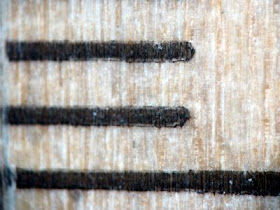
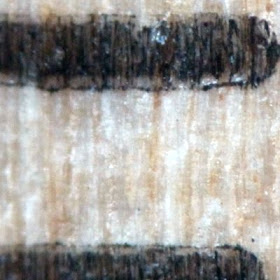 I proceeded to calibrate the camera with my stereo low-power microscope. Its visual magnifications are 7x, 15x, and 20x. I have a set of eyepieces that take the range to 30x, but the eye relief is smaller, making it harder to line up the camera. The third and fourth images are of the millimeter scale on a wooden ruler, using the 20x setting on the microscope and the camera's lens zoomed all the way "long". Direct scaling of the digital image yields a factor of 660 px/mm. The other image of the scale is an 800x800 crop, further reduced by Blogger to 400x400 (click to see the larger one).
I proceeded to calibrate the camera with my stereo low-power microscope. Its visual magnifications are 7x, 15x, and 20x. I have a set of eyepieces that take the range to 30x, but the eye relief is smaller, making it harder to line up the camera. The third and fourth images are of the millimeter scale on a wooden ruler, using the 20x setting on the microscope and the camera's lens zoomed all the way "long". Direct scaling of the digital image yields a factor of 660 px/mm. The other image of the scale is an 800x800 crop, further reduced by Blogger to 400x400 (click to see the larger one).Maximum displayed magnification is 168x, and maximum printed magnification is half that. Displaying the entire image at 400x300 pixel size has a magnification of 24x. Thus I have a set of factors to use if I need to report exact magnifications. Of course, as with a zoom lens, actual focal length is rarely reported, and for many microscopy purposes, reporting the original size of an object is often sufficient.
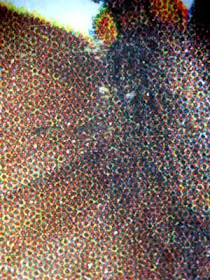
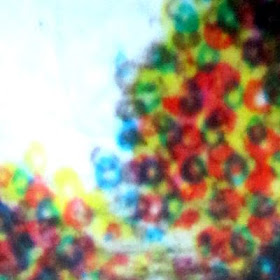 The fifth and sixth images show part of the butterfly on the stamp. First, the whole image at is shown at 24x, then a 400x400 crop that shows the halftone color dots making up the image, at 168x. This is the butterfly's eye.
The fifth and sixth images show part of the butterfly on the stamp. First, the whole image at is shown at 24x, then a 400x400 crop that shows the halftone color dots making up the image, at 168x. This is the butterfly's eye.Some part of the blurriness of the latter photo may be due to the camera optics, but I think most is the fuzzy edges of the dots themselves. I find it interesting that, as the ink dried on the shiny stamp paper, it migrated to the edge of each dot, forming a ring. I suspect it isn't really supposed to do that, and that the stamp would look better if the dots were solid.
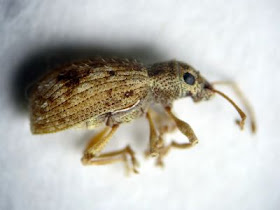
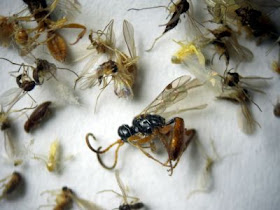 I grabbed another test subject I had on hand: a bunch of insects cleaned out of a light fixture and kept in a plastic vial. Spreading them out with a needle, I first separated a small weevil. Using the 15x setting and the camera zoomed all the way, I got this image (#7), shown here at about 17x (the weevil's length is 4mm, exclusive of antennae).
I grabbed another test subject I had on hand: a bunch of insects cleaned out of a light fixture and kept in a plastic vial. Spreading them out with a needle, I first separated a small weevil. Using the 15x setting and the camera zoomed all the way, I got this image (#7), shown here at about 17x (the weevil's length is 4mm, exclusive of antennae).The last image is more of a survey, meant to show the variety of critters the light had attracted, centered on a small wasp. The image's magnification is 8x. While that is in the range of the macro lens, I can crop a section of this photo to obtain 56x if needed, or 28x for a print.
All these photos were handheld. I have a small tripod, but it will take some fiddling to produce a setup in which the tripod-plus-camera can be quickly put into the right position. That will be more critical with my other, high-powered microscope, which doesn't let through nearly as much light. It may be some time before I am able to calibrate that setup.
No comments:
Post a Comment